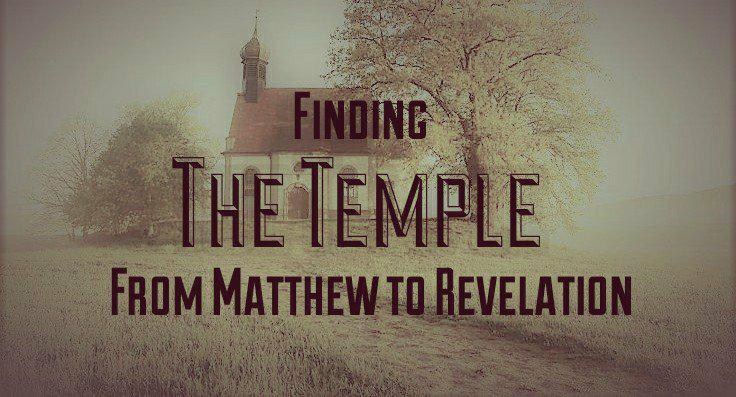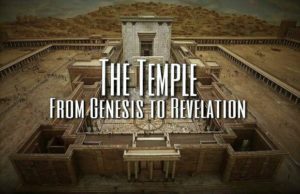Last week laid a foundation for the temple, as far as this theme is developed in the Old Testament. You should have learned the definition of the Temple of God- the dwelling place of God. The dwelling place of God took semi-permanent residence in the temple of Solomon. Having seen the temple of Solomon destroyed in 2 Kings 25:9, the scene is set for the arrival of the Temple of God in its fullest sense. What did the temple point towards in the Old Testament?
“And the Word became flesh and dwelt among us, and we beheld His glory, the glory as of the only begotten of the Father, full of grace and truth.” (John 1:14)
This passage in John’s gospel sets the scene for everything that takes place in the New Testament. This power-packed sentence echoes back to Exodus 33 when God dwelt in the form of a cloud in the tabernacle and on Mt. Sinai. Go back and read that chapter to see the link. Furthermore, the phrase “dwelt among us” (John 1:14) literally translated is “tabernacled”. Jesus- God in the flesh (Matt. 1:23)- came to dwell with His people in a form never before seen by man. What did the temple point towards in the Old Testament? The answer is Jesus Christ and His church.
Jesus as the Temple– In the Old Testament, God walked in the Garden of Eden in some form (Gen. 3:8), He appeared to Abram when establishing the great covenant (Genesis 15:17), He dwelt in the burning bush with Moses (Exodus 3:4), He filled the tabernacle of meeting (Exodus 40:34), and He fumigated the temple of Solomon (2 Chronicles 5:14). Meditating on the many places that God dwelt takes me back in time to the Dr. Seuss story Green Eggs and Ham. Sam I Am does not like green eggs and ham in a box. He does not like them with a fox. He does not like them with a mouse. He does not like them in a house. And so the story goes on and on. This listing of one locale after another is very similar to the oh-so many places that God’s veiled glory can be found in the Old Testament.
No more does God dwell in a literal house or appear in the form of a cloud. Paul describes Jesus’ coming to earth like this, “For it pleased the Father that in Him all the fullness should dwell,” (Colossians 1:19). And again, “He is the image of the invisible God,” (Colossians 1:15). Jesus was and is God to the nth degree. There is not a fiber of Christ that does not smell of the fire that God lit on Mt. Sinai in Exodus 33. He is Yahweh come to dwell in flesh, and anyone who says anything less is a blasphemer and an antichrist (2 John 1:7).
Recall the discussion of John 2:19-21 from Lesson 15. Jesus was there stating that He is the fulfillment of the temple, God come to dwell with His people. Unfortunately, Israel rejected God in the flesh just as they did God in the cloud. This is made obvious when Jesus acts out the vision of Ezekiel 10:18 by cleansing the temple (Matthew 21:12-13), defying the authorities of the temple (Matthew 21:14 – 23:39), and finally departing from the temple (Matthew 24:1-3), manifesting God’s utter disgust with Israel as they have defiled His holy sanctuary which was meant to be His dwelling place. God had finally come in the flesh to dwell in the house He made, and His own people have Him crucified for daring to do so.
The Church as the Temple– Jesus is the temple fulfilled. “Okay, I get that,” you say. However, the story doesn’t end there. When Jesus departed for the heavens in Acts 1:9, He did not do so without leaving a temple, a dwelling place for His covenant people to come and worship Him. No, Jesus did not leave a visible structure. Neither the Jewish temples, nor any other temple serve this purpose anymore. Instead, Paul says by inspiration to the church at Corinth,
“For you are the temple of the living God. As God has said: ‘I will dwell in them and walk among them. I will be their God, and they shall be My people.'” (2 Corinthians 6:16)
Paul quotes from Old Testament prophecy to prove that the church is the ultimate fulfillment of the temple of old. Know at least these three truths.
1) First, Paul explains how that Jesus and the church both combine to form the Temple of God, “And He put all things under His feet, and gave Him to be head over all things to the church, which is His body, the fullness of Him who fills all in all,” (Ephesians 1:22-23).
2) Second, the church universal incorporates all God’s faithful people, but Paul speaks to a local body of believers (church) in 2 Corinthians and Ephesians. He defines each local body as the dwelling place of God. The church is not physically a structure which God fumigates, nor does God get inside the body of each member of the church. So, how is the church like the temple?
3) Third, the church is to corporately function with Christ as its authoritative head, performing spiritual acts of worship in the presence of God. Peter describes the spiritual function of the church (temple of God) in his first epistle, “You also, as living stones, are being built up a spiritual house, a holy priesthood, to offer up spiritual sacrifices acceptable to God through Jesus Christ,” (2:5). This fact should magnify the holiness of the church assembled to worship.
This is a complicated study that I have tried my best to make simple. A five minute limit makes this feat even more difficult. Thus, if you like homework, I encourage you to read Revelation 21 & 22 in filling out this study. Look for the presence of God in the New Jerusalem as it is described by John. You will find that John describes the people of God reunited with God in a city described in terms of the Garden of Eden and the Temple of God.
Conclusion– This lesson marks the end of The Bible Themes Series. I hope you have personally benefited from this series and recommend it to others. If you would like to see a series on a specific locus of scripture or doctrine, please share your insights via the contact page. If you enjoyed this series, go check out the next series, What-You-Need-to-Know-About-the-Old-Testament.



